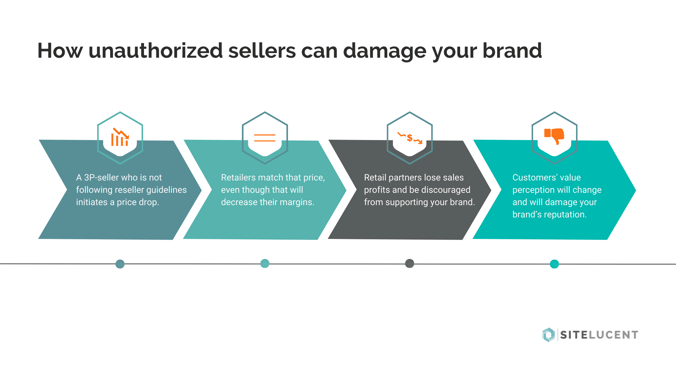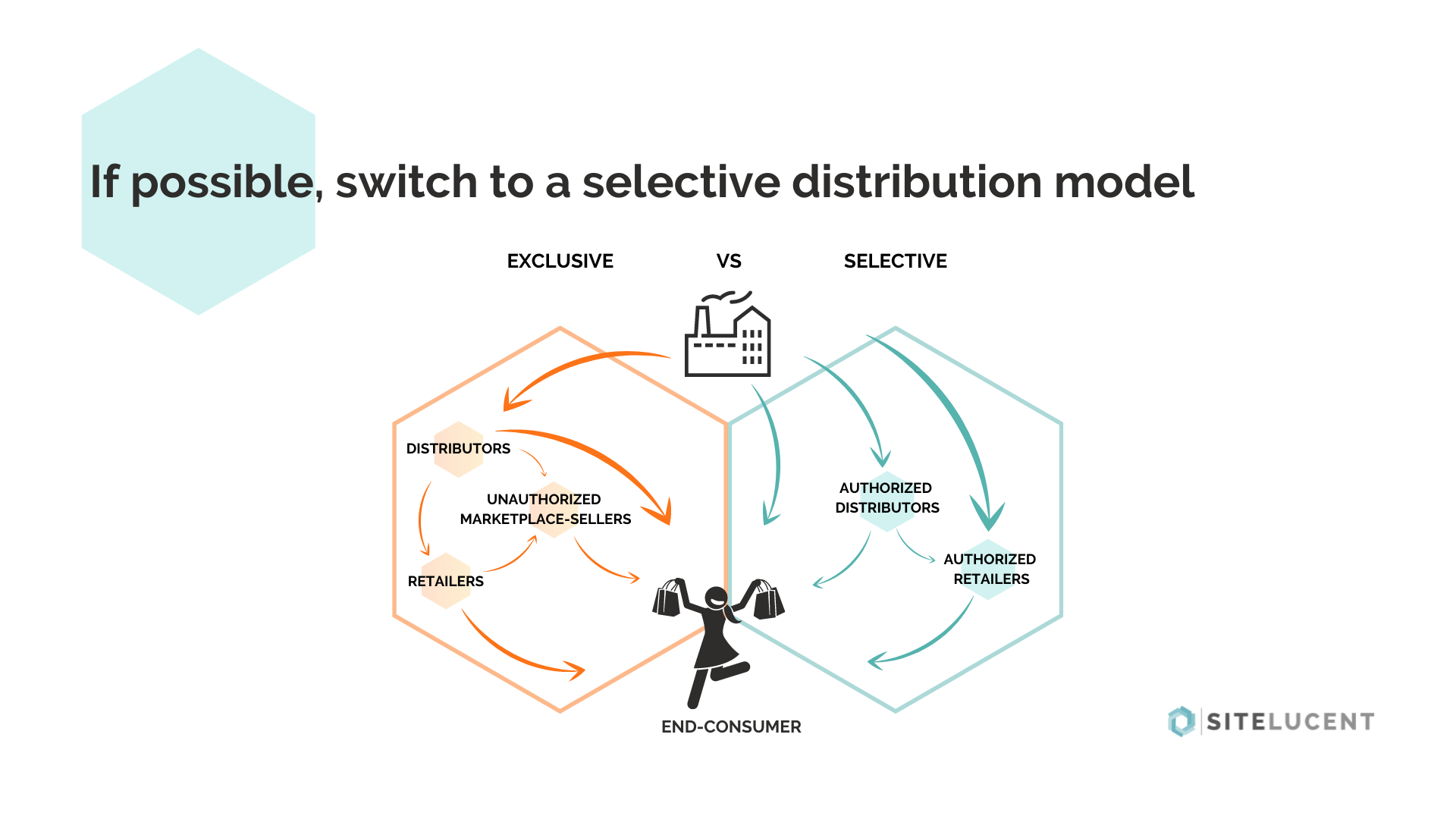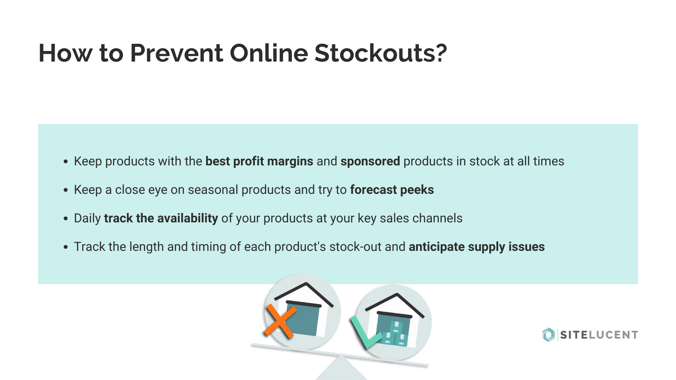Where, back in the day, brands distributed products via physical retailers only, employing merchandisers and mystery shoppers was (and still is) effective to control if products were visible and presented on the shelves as they wanted them to be to increase reseller sales.
You could do the same on the digital shelf by manually checking product pages one by one (a hell of a job!).
But, how great would it be if you could do that much more efficiently? To protect your brand's profitability, and in the end, BOOST your reseller's online sales?
In this blog, I will share how you can:
1. Control product distribution and prices
The first way to protect your brand's profitability online is to control who is selling your brand online, where, and for what price. By not letting too many retailers into a (saturated) market, you can avoid fierce price competition between them.
Do not allow too many resellers in a distributed area
When you allow too many retailers to sell your brand's products in a given territory, a price war can be created between retailers.
Unauthorized or rogue sellers often sell your products for discounted prices below your recommended sales price, forcing authorized sellers to reduce their prices. A price war is set in motion, leading to a race to the bottom.
Lower prices result in lower margins and profits for your brands' resellers. Shoppers evaluate a brand by its perceived value, which determines what they are willing to pay for your product. Record low prices can diminish the perceived value of a product, affect the actual quality and confuse buyers.

Finally, your products lose value, and the situation harms the relationship with authorized resellers.
By not letting too many retailers in a distributed area, you can:
- Create happy customers
- Have a good relationship with resellers
- Protect your brand image and value
- Make sure you and your resellers make (enough) money!
If possible, switch to a selective distribution model
Brands that follow the traditional exclusive distribution model have almost no control over how products are sold by their distributors and (unauthorized) sellers downstream end-users.
Once the authorized distributor sells to a retailer, that retailer will be free to sell to any customers in Europe, including on online marketplaces. This way, resellers can free-ride on the efforts of your brand’s authorized sellers, eventually discouraging those authorized sellers from supporting your brand and damaging your brand’s reputation.

Switching to a selective distribution model means you appoint a selection of authorized distributors/retailers that meet specific criteria to sell your products. This strategy can help you cut off supply to unauthorized sellers that are not within your brand's selection of distributors and resellers.
Using software to monitor who is selling your products can help you enforce this strategy.
Avoid price wars by daily tracking sellers and their prices
Suppose a reseller sells your products well below your recommended sales price (and possibly hurts your sales via your key resellers). In that case, it can be helpful to:
- Contact the seller and look for a reason and a possible solution together
- Identify the seller and cut off the supply
By tracking sellers and prices, you can also enforce price policies (such as a MAP policy) in the countries where they are used (be aware that Minimum Advertised Price policies are prohibited in the EU).
Enforce a Minimum Advertising Policy (MAP) in the countries where it can be used to prevent other sellers from undercutting recommended sales prices. A MAP policy is a policy or condition that dictates the absolute cheapest price a distributor or retailer can advertise a product for outside of the store.
Warn sellers who are violating your distribution and pricing policy. If the situation persists, take the necessary actions.
Uncover price trends in the market
Considering the EU legal pricing framework, price management needs to be done carefully and cautiously, but, on the other hand, price competition and smart management are not forbidden at all.
Your company can benefit from monitoring prices and price positioning in multiple ways!
-
Track and compare your prices to competitor brands' prices to select an optimal price strategy. For instance, keep the price below the average to wipe out the competition or above the average, to build the feeling of exclusivity.
-
Analyze the impact of changing prices: What happens if you increase purchase prices for your resellers? Do retail prices also increase? And competitor prices? And what is the effect of it on quantities sold?
-
Know which resellers maintain stable prices and get insights into reseller profit margins.
When discussing margins with resellers, you better be prepared!
Do you want to cover your costs, stay competitive, and ultimately profit? Then another way to leverage pricing data is using retail price data to back you up when negotiating prices with resellers.
When you analyze daily online selling prices for the previous months, you can use them to achieve the desired margins.
.png?width=1920&name=Webinar%203%20ways%20to%20boost%20your%20reseller%20sales%20(1).png)
By knowing the retail price, you can calculate the profit margin of your resellers and if it's in line with the brand's profit margin.
2. Connect your brand website with retailers
New visitors are at your brand's website for two reasons
Broadly said, visitors are only at your site for one of two reasons:
- To research your products
- To purchase your products
Consumers do not follow a predefined path to purchasing online; there are hundreds of ways a visitor's journey to each goal can play out.
It’s not common for visitors to your brand's website to instantly buy your products after the first interaction. 83% of online shoppers intend to understand if your products can solve their pain or need when visiting a brand’s website for the first time, according to recent studies.
Can your brand compete with the high-level shopping experience of retailers?
There are many reasons why shoppers won't buy from your brand's website, such as:
- Your brand's website does not have the functionality of a webshop
- A product ran out of stock
- The high-level shopping and customer experience of online retailers and marketplaces have a shopper's preference.
No matter what your strategy or goal as a brand is, you want to help visitors successfully reach their destination by removing as much friction from your brand's website experience as possible.
After visitors leave your brand's website (because they couldn't or wouldn't buy from you directly), you have no clue where these visitors go, and if they make a purchase, once they leave your website. In other words, did they reach their (and your) goal?
That’s where a where-to-buy solution can come in handy! A where to buy button forwards shoppers directly to the right product page of the retailer, where they can buy the product.
.png?width=1920&name=Webinar%203%20ways%20to%20boost%20your%20reseller%20sales%20(2).png)
A where-to-buy solution lets shoppers choose their preferred sales channel. That can be either to buy products from you directly or from an online (or offline) retailer, meeting the need for a seamless customer experience and preventing unnecessary loss of sales.
On top of that, you can uncover more insights into your brands' clicks, sales, and revenue data. If you combine clickstream and conversion data with digital shelf data, you can uncover insights to optimize the eCommerce pages of your retailers representing your brand.
3. Maximize product stock availability
No brand wants to drive traffic to a product page that then fails to convert at the final moment because the retailer doesn't have the product in stock.
In most cases, poor shelf replenishment practices cause stockouts. Between 70 and 90% of stockouts are caused by poor shelf replenishment practices.
Especially when you need to track inventory across multiple channels, stock replenishment and demand forecasting become more critical yet complicated.
Running out of stock can cause lost sales in the short term: You miss an occasional purchase or multiple repeat sales.
Running out of stock frequently has also long-term effects:
-
The more frequently your products run out of stock, the fewer chances of showing up on the top of search results. Poor availability in the past 20 days can cause an average drop of 4 to 5 positions in eCommerce search results.
-
If your products run out of stock on a marketplace, you lose the buy button. Overall, marketplace algorithms prefer sellers with a full inventory most of the time.
-
When your products often run out of stock, you jeopardize customer loyalty: big chance that shoppers will choose an alternative brand.
Overall, stockouts can cause missing sales and bad customer experiences that damage your brand's reputation in the long term.
How to Prevent Online Stockouts?
Sponsored products and products with high-profit margins, newly introduced products, or your famous best-sellers are the ones you want to keep an eye on closely since they will have the most negative effect on your brand when they run out of stock.

-
Daily track if your core portfolio is listed and available. Monitoring tools like SiteLucent automatically notify you if products run out of stock.
-
Track the length and timing of each product’s stockout and anticipate potential supply issues in the future.
-
Talk to resellers about how to optimally manage your inventory. Both you and your resellers will benefit!
Curious to see what it looks like in SiteLucent? Watch our on-demand webinar!
-1.png?width=1200&name=Webinar%20Boost%20Reseller%20Sales%20LinkedIn%20(1)-1.png)


.png?width=1920&name=Webinar%203%20ways%20to%20boost%20your%20reseller%20sales%20(1).png)
.png?width=1920&name=Webinar%203%20ways%20to%20boost%20your%20reseller%20sales%20(2).png)

-1.png?width=1200&name=Webinar%20Boost%20Reseller%20Sales%20LinkedIn%20(1)-1.png)